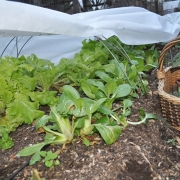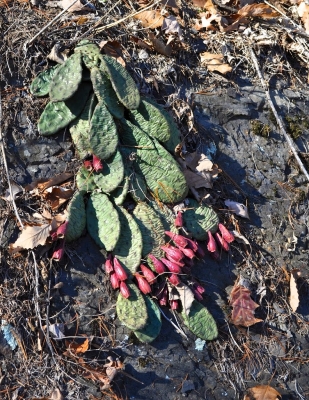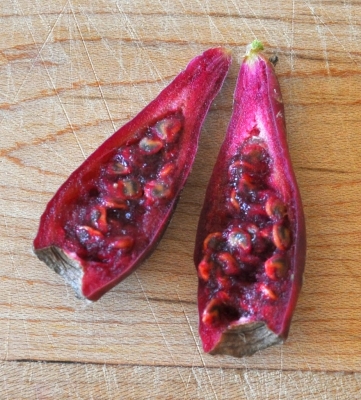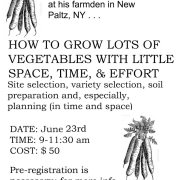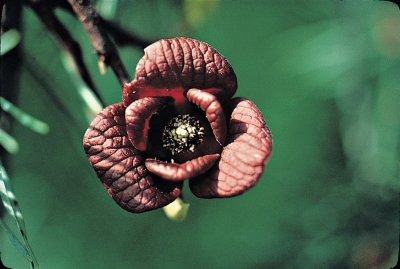FIGS, POMEGRANATES, LETTUCE, BEDS: ALL READY
Beds Ready for Spring Planting, Figs and Lettuces Readied for Cold
Much colder weather has been sneaking in and out of the garden but leaving traces of its presence with some blackened leaves on frost-sensitive plants and threatening to brazenly show itself in full force sometime soon. This fall I vow to put all in order before that event rather than, on some very cold night, running around, flashlight in hand, gathering and protecting plants.
Before even getting to the plants, drip irrigation must be readied for winter. Main lines and drip lines can remain outdoors but right near the spigot, the timer, the filter, and pressure reducer must be brought indoors where they won’t freeze. I plug the inlet for the drip’s main line to keep out curious insects. At the far end of the line is a cap that I loosen enough to let water drain out. Opening all other valves along the line leaves no dead ends in which freezing water could expand to break lines.
Begonia, amaryllis, Maid of Orleans jasmine (Jasminium sambac), and other topical plants are next in importance. Being near the radiating warmth of the house has spared them recent slightly frosty nights. Colder temperatures would not be so kind. I snap the stems off the begonias right at ground level and put the pots in the basement where cool temperatures will keep the tubers dormant to wait out winter. Amaryllis plants also go into the basement. Cool temperatures and lack of water for a couple of months give these plants the rest period they need so that, brought upstairs to a warm, sunny window, their blossoms can show off their bright, red color against the achromatic winter landscape beyond.
Maid of Orleans jasmine right away gets a prominent place in a sunny window to share its nonstop, sweet fragrant blossoms.
Figs, Pomegranates, & Subtropicals Readied for Cold, But Not Too Much
Fig, pineapple guava, Chilean guava, and pomegranate are subtropical plants that tolerate temperatures down into the ‘teens so can remain outdoors for weeks to come. Still, many of these plants are in large pots, not something I want to be lugging around following at last minute threat of frigid temperatures. So I’ll gather them together in a convenient location for quick dispatch indoors when needed.
The guavas, as well as kumquat and common jasmine (Jasminium officinale), are evergreen subtropical plants. The leaves are important to these plants both for beauty and for function so they’ll make the move indoors before the other subtropicals to make sure their leaves go into winter undamaged.
Common jasmine stays out longest because some exposure to cold is needed to get blossoms in winter.
Cold Weather Vegetables for Weeks to Come
The vegetable garden is still green with endive, kale, lettuce, turnips, Brussels sprouts, arugula, and other cold-hardy vegetables. Soon, though, their cold tolerances will be tested. I’ll pre-empt that testing by covering some of the beds with tunnels of fabric (“fleece” to the Brits, “floating row covers” to us colonists) or clear plastic. No need yet to cover the plants but better to have the metal hoops which support the fleece or plastic in place and ready for the covering before that frigid night to come.
Not all hardy vegetables get covered; just the leafy ones — lettuce, mustard, arugula, and endive — for fresh salads in the weeks to come. Brussels sprouts and kale are so cold hardy that they can go for weeks without protection, and, anyway, they’re too tall to cover. Leeks also can stay outdoors unprotected until December, or later, then get dug up and packed together in a box or large pot to store in the basement and use as needed.
Carrots, beets, turnips, and winter radishes enjoy the protection of the earth. With a deep mulch of leaves or straw, they could remain tender and unfrozen all winter. More convenient for eating is to dig them up just before really frigid weather descends on the garden and pack them in boxes with dry leaves to store in the cool temperatures of the basement. I’m putting off deciding which option to choose.
Fresh Lettuce ‘Til When?
Someone recently told me that they gardened maniacally all summer and now they are finished for the season . . . which reminds me of some more things that I still have to do. Plant garlic. I planted cloves back in early September; a second planting, now, will give some indication if early or late planting is better. Mulch blueberries as soon as their leaves all drop. Sift compost and garden soil into buckets to store for making potting soil in late winter. Cut down asparagus plants after the tops yellow, and mulch the bed. Clean up spent vegetable beds of tomatoes, peppers, and eggplants and spread them with an inch depth of compost. Mow hayfield and lawn to expose rodents to predators and, in the hayfield, to keep blackberry, sumac, and autumn olive from taking over. Plant bulbs (a large, naturalized planting of alliums; more on that some other time).
I’d also like to divide older plants in a flower bed and dig out weeds that are starting to think they’re home. And build a rustic fence to hid the propane tank for the greenhouse.
I’m not yet ready to throw in the trowel for this season.




